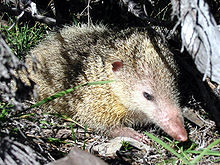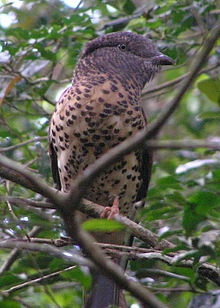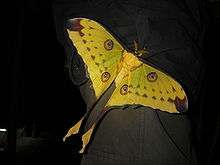- Fauna of Madagascar
-
The fauna of Madagascar is a part of the wildlife of Madagascar.
Madagascar has been an isolated island for about 70 HI million years, breaking away from Africa around 165 million years ago, then from India nearly 100 million years later. This isolation led to the development of a unique endemic fauna.
Before humans arrived about 2,000 years ago there were many large and unusual animals living there, descended from species that were originally present when Madagascar became an island, or from species that later crossed the sea to Madagascar. Ecological niches were often filled by animals with quite different histories from those on the African mainland, often leading to convergent evolution. A large proportion of these endemic Malagasy animals have died out since the arrival of humans, most particularly the megafauna.
Despite this, and massive deforestation, Madagascar is still home to an incredible array of wildlife, the vast majority of which is unique in the world.[1] Madagascar is a primary spot for ecotourism,[2] with more than fifty national parks and other protected reserves.
There are believed to have been only five colonization events of terrestrial mammals from mainland Africa. They are the tenrecs, the lemurs, the Malagasy carnivorans, the nesomyine rodents, and the now-extinct bibymalagasians. The other mammalian colonizations are the amphibious hippopotamuses (now extinct) and bats.
 Common tenrec (Tenrec ecaudatus), the largest of the tenrecs.
Common tenrec (Tenrec ecaudatus), the largest of the tenrecs.
Contents
Mammals
Main articles: List of mammals of Madagascar and List of lemur speciesThe lemurs are the best known of Madagascar's mammals. In the absence of monkeys and other competitors, these primates have adapted to a wide range of habitats and diversified into numerous species. The tenrecs are another group of mammals characteristic of Madagascar. Most of the world's species of these small to medium-sized insectivores are found on the island. Rodents are poorly represented on the island with only a handful of native species, all belonging to the subfamily Nesomyinae. They include the large, endangered Malagasy giant rat. Due to their ability to fly, a greater variety of bats have reached the island. However only about a third of these are endemic, a lower proportion than in other groups of land mammals. There are eight members of the Carnivora on the island, all now classified in the endemic family Eupleridae. The cat-like fossa is the largest of these.
Malagasy living mammals
Lemurs: As of 2008, there are officially 99 species and subspecies of lemur, 39 of which have been described by zoologists between 2000 and 2008.[3] They are almost all classified as rare, vulnerable, or endangered.[4]
Eupleridae: Primary among these malagasy carnivores is the fossa (Cryptoprocta ferox), a type of civet despite its feline appearance. Other Malagasy carnivores include the fanaloka (Fossa fossana), which, despite its scientific name , should not be confused with the fossa. Nor should it be confused with the very similarly named falanouc (Eupleres goudotii), also known as the Malagasy Small-toothed Civet. Five species of mongoose are also found in Madagascar, as is the Small Indian Civet, the only carnivore believed to have been introduced to the island.
Tenrecidae: Three species of tenrec (the otter shrews) are found on the African mainland. The majority of tenrecs, around 30 species, are found in Madagascar. They have radiated into many different niches. For example web-footed tenrecs (Limnogale mergulus) resemble river otters in appearance and behaviour. The Lesser Hedgehog Tenrec (Echinops telfairi) resembles its namesake the hedgehog.
Rodents: About 30 species of indigenous rodent are known from Madagascar, three of which are now extinct. They are all members of the muroid subfamily Nesomyinae. These have also radiated into various niches, with vole-like forms, arboreal mice, fossorial varieties, and rabbit-like forms.
Bats: Approximately 45 species of bat are known from Madagascar, more than half of which are endemic to the island (see List of bats of Madagascar).
Malagasy extinct mammals
Bibymalagasians (Plesiorycteropus madagascariensis): One or two species of these enigmatic, aardvark-like insectivores may have gone extinct about 1000 years ago. They have been assigned their own order, Bibymalagasia.
Giant Lemurs: At least 17 species of lemur have become extinct since man arrived on Madagascar, all of which were larger than the surviving lemur species. They include the Giant Aye-aye, three to five times as heavy as the extant species. Megaladapis, which had three species, reached the size of orangutans. The eight sloth lemurs show remarkable evolutionary convergence with the South American sloths; Palaeopropithecus was chimpanzee-sized, while Archaeoindris grew to over 200 kg,[5] more massive than a silverback gorilla.
Giant Fossa (Cryptoprocta spelea): The fossil record of Madagascar has yielded the remains of a giant, recently extinct fossa, which was about a quarter larger than the living species,[6] making it close to the size of an ocelot. This species was believed to have preyed upon the larger lemurs that inhabited Madagascar until the island was settled by man.
Malagasy Hippopotamuses: There are thought to have been three species of dwarf or pygmy hippopotamus in Madagascar,[7] the last of which died out no earlier than 1,000 years ago, probably as a result of human settlement of the island.
 Cuckoo-roller (Leptosomus discolor), the only member of a family unique to Madagascar and the nearby Comoros.
Cuckoo-roller (Leptosomus discolor), the only member of a family unique to Madagascar and the nearby Comoros.
Birds
Main articles: List of birds of Madagascar and Endemic birds of Madagascar and western Indian Ocean islandsAbout 280 species of bird have been recorded on Madagascar and about 200 of these breed. Although these are relatively low numbers for a large tropical island, there is a high degree of endemism. Over 100 bird species are endemic and 49 of these are restricted-range endemics with a range of less than 50,000 km2. There are five bird families unique to Madagascar or shared only with the Comoro Islands: the mesites, the ground-rollers, the cuckoo-roller, the asities and the vangas. In addition, recent studies suggest that several songbirds should be grouped together in a new endemic family: the Malagasy warblers.
Elephant Birds (Aepyornis maximus): These enormous birds were over 3 metres tall and half a tonne in weight. They are thought to have become extinct within the last millennium, as a result of human activity, like the dodo on the neighbouring island of Mauritius.
 Panther chameleon (Furcifer pardalis), a large chameleon which has adapted to man-made habitats.
Panther chameleon (Furcifer pardalis), a large chameleon which has adapted to man-made habitats.
Reptiles
Relatively few families and genera of reptile have reached Madagascar but they have diversified into more than 260 species, with over 90% of these being endemic. The chameleons are very well represented with two-thirds of the world's species found there. The other lizard groups on Madagascar are the geckoes, skinks, girdle-tailed lizards and iguanids. Over 60 different snakes occur on the island; none of these are harmful to man. There are six land tortoises species, five endemics and one introduced species (Bell's hinge-back tortoise and the subspecies Madagascan hinge-back tortoise). Land based turtles include the African helmeted turtle, yellow-bellied mud turtle, East African yellow-bellied mud turtle, East African black mud turtle . The shores are used for nesting by the loggerhead sea turtle, green sea turtle and hawksbill sea turtle while the olive ridley sea turtle forages here.[8] Madagascar's largest reptile is the Nile crocodile which has become very rare due to hunting for its skin.
Madagascar is a stronghold for a wide diversity of endemic species of chameleons and is considered the radiation point for day geckos. The two genera of iguanas present have a basal relationship to other iguanas and are believed to have been present on the island since it separated from Africa.[9] The Madagascar big-headed turtle, spider tortoise, flat-backed spider tortoise, radiated tortoise and ploughshare tortoise are endangered species.[8]
- Chameleon genera found in Madagascar: Calumma, Furcifer and Brookesia
- Iguanian (or iguanid) lizards of Madagascar
Amphibians
Main article: Amphibians of MadagascarThere are more than 150 amphibians in Madagascar with new species being found regularly. Nearly all of these are endemic and the majority are restricted to primary forest.
Comet moth (Argema mittrei), one of the world's largest moths.
Insects
Madagascar is home to huge variety of insects, the majority of which are endemic. Thousands of species are present in some groups such as the beetles and moths. Distinctive species include the long-necked giraffe weevil, the huge comet moth and the butterfly-like Madagascan sunset moth. About 80 species of stick insect occur; the Achrioptera species are large and colourful while others are small and very well-camouflaged. Many of the island's praying mantises are also well-camouflaged, mimicking dead leaves or bark. There are over 100 cockroaches, including the large Madagascar hissing cockroach.
Beetles: Various species of beetles. For example various tiger beetles (Cicindelidae): 109 species from genus Pogonostoma,[10] 65 species from genus Physodeutera.[11]
Madagascar is home to the smallest bee in the World, Liotrigona bitika (Brooks & Michener 1988) with a body length of less than 2 mm, and to several other species of Meliponini.[12]
 Robust ghostpipefish (Solenostomus cyanopterus) off Nosy Be.
Robust ghostpipefish (Solenostomus cyanopterus) off Nosy Be.
Spiders
Main article: List of spiders of MadagascarMolluscs
Main article: List of non-marine molluscs of MadagascarMarine life
The seas around Madagascar host a high diversity of wildlife, including invertebrates.[13] There is a still a large area of mangrove swamp around the coast, particularly in the west, and there are extensive coral reefs around the island. Thousands of fish species occur, including the rare coelacanth. Four species of sea turtle breed on the beaches, but many are taken for food by local people. Humpback whales breed off the south-western coast.
Native names for extinct megafauna
- Birds
- Vorompatra: Aepyornis
- Lemurs
- See Subfossil lemur.
- Tratratratra, tretretretre: probably Palaeopropithecus (a type of sloth lemur) or Hadropithecus
- Tokandia: probably Megaladapis (koala lemur)
- Kidoky: Hadropithecus or Archaeolemur. (monkey lemurs, baboon lemurs) There are unproved stories of a species of kidoky surviving: see this link.
- Others [3]
- Kilopilopitsofy, tsomgomby, railalomena: Malagasy Hippopotamus
- Antamba: Cryptoprocta spelea or similar
In popular culture
- As a part of conservation efforts, the Wildlife Conservation Society has recently opened a Madagascar! exhibit at the Bronx Zoo.
- The 2005 animated film Madagascar featured a number of animals of Madagascar as cartoon characters.
See also
References
- ^ Benstead, Jonathan P.; Goodman, Steven D. (2003). The natural history of Madagascar. Chicago: University of Chicago Press. ISBN 0-226-30306-3.
- ^ Schuurman, Derek; Nick Garbutt; Bradt, Hilary (2001). Madagascar Wildlife: A Visitor's Guide (2nd ed.). Bradt Travel Guides. ISBN 1-84162-029-7.
- ^ Mittermeier, R., Ganzhorn, J., Konstant, W., Glander, K., Tattersall, I., Groves, C., Rylands, A., Hapke, A., Ratsimbazafy, J., Mayor, M., Louis, E., Rumpler, Y., Schwitzer, C. & Rasoloarison, R. (December 2008). "Lemur Diversity in Madagascar". International Journal of Primatology 29 (6): 1607–1656. doi:10.1007/s10764-008-9317-y.
- ^ Jane Thornback; Harcourt, Caroline (1990). Lemurs of Madagascar and the Comoros: The IUCN Red Data Book. World Conservation Union. ISBN 2-88032-957-4.
- ^ Jungers WL, Godfrey LR, Simons EL, Chatrath PS (October 1997). "Phalangeal curvature and positional behavior in extinct sloth lemurs (Primates, Palaeopropithecidae)". Proc. Natl. Acad. Sci. U.S.A. 94 (22): 11998–2001. Bibcode 1997PNAS...9411998J. doi:10.1073/pnas.94.22.11998. PMC 23681. PMID 11038588. http://www.pnas.org/cgi/pmidlookup?view=long&pmid=11038588.
- ^ Goodman SM, Rasoloarison RM, Ganzhorn JU (2004). "On the specific identification of subfossil Cryptoprocta (Mammalia, Carnivora) from Madagascar". Zoosystema 26 (1): 129–143. http://www.mnhn.fr/museum/front/medias/publication/1334_z04n1a9.pdf.
- ^ Nick Garbutt (1999). Mammals of Madagascar. New Haven, Conn: Yale University Press. ISBN 0-300-07751-3.
- ^ a b Rhodin, Anders G.J.; Paul van Dijk, Peter; Inverson, John B.; Shaffer, H. Bradley (2010-12-14). "Turtles of the World 2010 Update: Annotated Checklist of Taxonomy, Synonymy, Distribution and Conservation Status" (pdf). Archived from the original on 2010-12-15. http://www.webcitation.org/5uzfktoIh. Retrieved 2010-12-15.
- ^ Okajima, Y.; Kumazawa, Y. (2009-07-15). "Mitogenomic perspectives into iguanid phylogeny and biogeography: Gondwanan vicariance for the origin of Madagascan oplurines". Gene (Elsevier) 441 (1-2): 28–35. doi:10.1016/j.gene.2008.06.011. PMID 18598742.
- ^ Moravec Jiří (2007). "A monograph of the genus Pogonostoma" (30 colour plates, 499 pp.). Tiger beetles of Madagascar. 1. Zlín: Nakladatelství Kabourek. ISBN 978-80-86447-13-1. http://www.kabourek.cz/vypis_c_detail.php?TBK=1&N=&KC=TBM%2001&R=.
- ^ Moravec Jiří (2007). "A monograph of the genus Physodeutera" (21 colour plates, 290 pp.). Tiger beetles of Madagascar. 2. Zlín: Nakladatelství Kabourek. ISBN 978-80-86447-13-1. http://www.kabourek.cz/vypis_c_detail.php?TBK=1&N=&KC=TBM%2002&R=.
- ^ Koch, H. 2010. Combining morphology and DNA barcoding resolves the taxonomy of Western Malagasy Liotrigona Moure, 1961. African Invertebrates 51 (2): 413-421.[1]PDF fulltext
- ^ Dell'Angelo, B., Prelle, G., Sosso, M. & Bonfitto, A. 2011. Intertidal chitons (Mollusca: Polyplacophora) from southern Madagascar. African Invertebrates 52 (1): 21-37.[2]
External links
- Moravec J. (2010): Tiger Beetles of the Madagascan Region (Madagascar, Seychelles, Comoros, Mascarenes, and other islands) Taxonomic revision of the 17 genera occurring in the region (Coleoptera: Cicindelidae),430 pp.
- Madagascar and other Islands: Human Settlers Invade Paradise
- New York Academy of Sciences Podcast
Fauna of Africa Sovereign
states- Algeria
- Angola
- Benin
- Botswana
- Burkina Faso
- Burundi
- Cameroon
- Cape Verde
- Central African Republic
- Chad
- Comoros
- Democratic Republic of the Congo
- Republic of the Congo
- Côte d'Ivoire (Ivory Coast)
- Djibouti
- Egypt
- Equatorial Guinea
- Eritrea
- Ethiopia
- Gabon
- The Gambia
- Ghana
- Guinea
- Guinea-Bissau
- Kenya
- Lesotho
- Liberia
- Libya
- Madagascar
- Malawi
- Mali
- Mauritania
- Mauritius
- Morocco
- Mozambique
- Namibia
- Niger
- Nigeria
- Rwanda
- São Tomé and Príncipe
- Senegal
- Seychelles
- Sierra Leone
- Somalia
- South Africa
- South Sudan
- Sudan
- Swaziland
- Tanzania
- Togo
- Tunisia
- Uganda
- Zambia
- Zimbabwe
States with limited
recognition- Sahrawi Arab Democratic Republic
- Somaliland
Dependencies and
other territories- Canary Islands / Ceuta / Melilla / Plazas de soberanía (Spain)
- Madeira (Portugal)
- Mayotte / Réunion (France)
- Saint Helena / Ascension Island / Tristan da Cunha (United Kingdom)
- Western Sahara
Categories:- Endemic fauna of Madagascar
- Fauna of Madagascar
- Lists of animals by country
Wikimedia Foundation. 2010.


